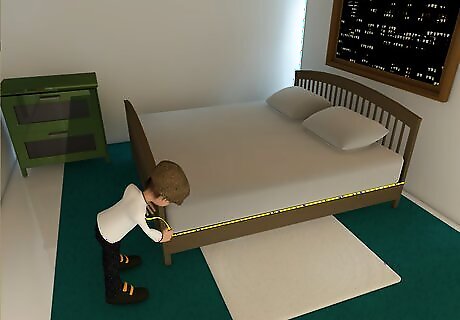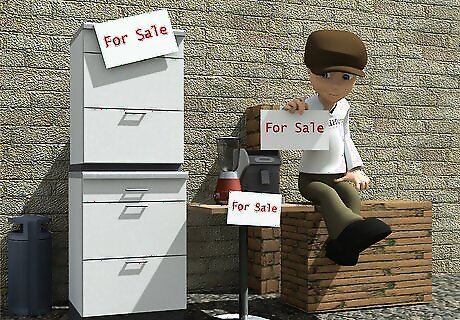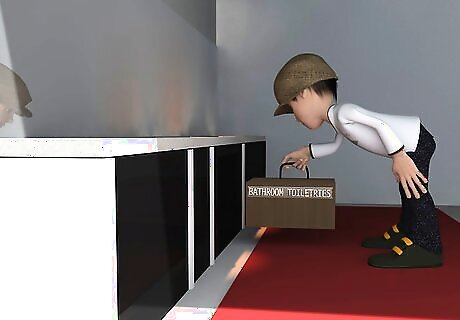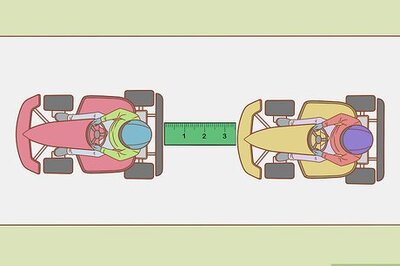
views
Now is the time to get rid of excess baggage (literally!) and pare down to the essentials.

Assess your actual needs. Someday, you may take up exercising, but the treadmill/Stairmaster/Bowflex has been gathering dust for some time. Wouldn’t a good pair of walking/running shoes be more useful and take up significantly less space? Does anyone actually sit in the chair in the corner? How often do you eat at the table? When was the last time you used your stereo? Deciding what you really need requires a good long look at how you live your life daily and prioritizing the activities and items that are already a part of your actual lifestyle--not those activities or items that you want to be part of your lifestyle, but haven't gotten around to yet. Take a walk through your house or apartment and evaluate everything you come across (furniture, books, food, etc.). Ask yourself if you've used it in the past year and, if so, how often? Be honest with yourself. If you think you could live well without it, out the door it should go. Make a note of it. Consider that most of the stuff people keep without using is a tribute to an unmet goal. The most common example is probably exercise machines that we always say we'll use, but don't. Then there are those books we intend to read, that table we eventually want to have dinners and brunches on, etc. We keep things around "just in case", or hoping that their presence will eventually encourage us to use them. But let's be realistic, if seeing that treadmill get a coating of dust hasn't inspired you yet, what makes you think it ever will? Make room for the things you'll actually use. For stuff that you really have a hard time getting rid of, make this agreement with yourself: Put the items in storage. If you don't need or use them within 6 months, give, sell or throw them away.

Go through your home, every cabinet, shelf and closet should be cleared. Only put back the things you couldn't live well without. That means that if you use a whisk every other day it stays but the melon-baller when you don't even like melon... Out it goes. Put these items in boxes, crates or bags in a garage or other storage area

Measure your furniture. You will need to know how your furniture will (or won’t) fit into your new space - particularly large items such as your sofa and your bed - so measure everything.You will also need to get the room measurements of your new space. Ask if you can take measurements or if there is a floor plan available to you. Don’t forget about the location of doors and windows as this will be a factor in furniture placement. Once you have these measurements, make a floor plan using your furniture’s measurements. Try using Better Homes and Gardens’ Arrange-A-Room online software to simplify the process (requires registration but is free). This will give you a much better idea on what you can keep and what will have to go.

Assess your new storage areas. How many times have you moved into a new place only to realize - too late - that you have overestimated the amount of storage space? While you’re getting room measurements, make sure to properly assess the storage situation you’ll be inheriting. Will you have fewer kitchen cupboards? How many closets will you have? If you are moving into an apartment, does it have a storage locker and, if so, what are its dimensions? Assessing exactly how much of the new space is dedicated to storage will give you and idea of the volume of items you need to dispose of before moving in. Don’t forget hidden storage areas you currently use in your old place. If you place a lot of items above the kitchen cabinets in your current home, for example, find out if the cupboards in the new place have storage in that area as well. In a small place, you should try to maximize vertical space whenever possible. Floating shelves are a great option!

Ransack your old storage areas. Go through your storage areas first (attics, basements, closets, etc). You will be surprised to find out what you’ve put away instead of gotten rid of. If you’re like most of us, you will find boxes of items that haven’t seen the light of day for years and there’s a reason for this: you don’t need them. Get rid of them at once. Hesitation will only melt your resolve. Don’t forget to go through your bathroom cabinets, kitchen and “junk” drawers. We have a tendency to accumulate unnecessary items in these places. Get rid of empty bottles, balls of twine, expired medicines and beauty products, and your collection of plastic margarine containers. Be brutal. How you dispose of these unnecessary items will depend on how much energy and/or time you have. The easiest thing to do is to load them up on a truck and drop them off at the nearest thrift shop. Join a Freecycle group to give stuff away (www.freecycle.org) If you live in an apartment building or townhouse complex, notice boards and drop off areas for giving unwanted items to neighbors are sometimes provided. Call up your friends and relatives and see what they need. You may be able to enlist their help in the move for a promised dresser/bed/armchair!

Sell your stuff. If you’re in need of a pre-move windfall, try these: For a large number of items, have a yard sale (or a series of yard sales), or if you have a lot to sell quickly, consider a service to take care of it for you (e.g., Google liquidation estate content sales). If you have time before the move, utilize sites such as Craigslist and eBay to sell off the best stuff. You’ll likely get more money for your items this way but it is more time consuming. Craigslist is a good avenue for selling larger items such as furniture, appliances and home décor items to people living in your area. If you have the means, offering delivery will often produce quicker sales. eBay is a good venue for selling collectible items such as old albums, comic books, and figurines. Make sure to take good quality photos of the items and offer good descriptions. Remember that you are a salesperson. Sell those products! Used designer clothing can be resold in consignment shops. These stores can be found in your local business directory. Be sure to shop around. Some stores offer better rates than others.

Get organized. Before you move into your new place, it’s a good time to work out some storage solutions for your stored items. You can do this as you pack. Place your storage items in decorative storage boxes that can be moved and placed in the new storage areas without much effort. Plastic bins are great for moving and storing, come in many sizes, are stackable, and the see-through ones make finding what you need a snap. The measurements taken of the new storage areas will ensure a good fit. Come moving day, these boxes will be much easier to deal with. Label everything by room. Don’t think that you will remember that the big television box is actually full of pots and pans. You won’t.

Move large items first. Move your furniture into your new home first. You will have the most energy for this task at the beginning of the move and it will also give you a better indication of where the smaller things will go. Do not merely fill a room with furniture with the idea of sorting it all out later. There is nothing worse than trying to navigate through small rooms littered with boxes and stacks of furniture after a day of moving.Place furniture in the rooms as you go, according to the plan you made earlier. If you have done your homework correctly, your big items should fit in nicely and already give you a sense of home (and a place to sit while taking a break from all of your hard work!)

Put away storage items. Contained items that are meant for storage can be placed directly in their allotted spaces where they will be out of the way. By putting these things away as you move in, you’ll be saving yourself the stress of trying to maneuver through tiny, packed rooms during the next few days.

Organize boxed items. Your labeled boxes can now be put into their respective rooms and the unpacking can begin. Begin with the bathroom, as that is the room most likely to be needed immediately. If you have only kept the basics, unpacking this room will be a breeze.

Organize your space as you unpack. Utilize closet and cupboard storage solutions as you unpack. This way, more can be stored in these tight spaces and you will be setting a precedent for how your new, smaller space will be used. Don’t fall back into lazy habits or your downsized place will get you down.

Relax and enjoy! You have now entered the realm of living small. You no longer have to worry about the financial burden or time draining tasks of maintaining a home too big for your needs and you have simplified your life by surrounding yourself with only those things that are most important to you. Rejoice!




















Comments
0 comment